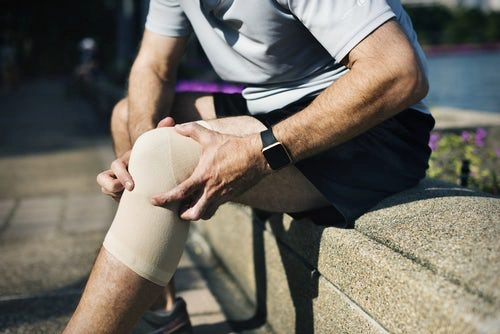If you have ever sprained your ankle or strained your back, you know how terribly painful these conditions can be. For those not involved in the medical field, the words sprain, and strain are often used interchangeably, even though they are different injuries.
What is the difference between a sprain and a strain?
What Is a Sprain?
A ligament is a collection of tough, fibrous tissue that connects the bones to other bones or to cartilage. Ligaments are usually found in and around the joints. A sprain is a torn, twisted, or overstretched ligament. Common joints that get sprained are wrists, thumbs, knees, and ankles.
What Is a Strain?
Tendons are also tough cords of fibrous tissue that connect the muscles to the bones. A strain is a torn, overstretched, or twisted tendon or muscle. While any muscle or tendon in the body can become strained, the most common places for strains are knees, feet, legs, and the back.
Sprain VS Strain Symptoms
Keep in mind that sprains usually occur around joints. Sprains often happened quickly, with symptoms that can be quite severe or mild, depending on the injury and how many tissue fibers were involved.
Symptoms of a Sprain include:
- A popping noise or sensation at the time of the injury
- Pain
- Swelling
- Bruising
- The inability to use the joint normally or to put weight on it
- Limited movement of the joint
While a strain can also occur suddenly, it can also develop slowly over time.
Symptoms of a Strain are like a sprain and include:
- Limited movement in the area
- Muscle weakness
- Pain or tenderness
- Swelling
- Bruising
- Muscle cramps or spasms
Special Note:
A sprain can have serious complications, depending on the severity of the issue. If you experience any of the following, seek medical attention as soon as possible:
- The injured area of the body becomes completely numb
- You are still unable to walk or use the joint at all after 4 or 5 days
- Blood is oozing from the injury
- You are unable to move your arm or leg
How Long Will It Take for a Sprain to Heal?
This is difficult to estimate since sprains can vary in severity, the area injured, as well as the overall health and age of the patient. An 80-year-old diabetic, for example, will take far longer to heal from a sprained ankle than a 25-year-old professional athlete.
Getting proper treatment, however, will help all strains and sprains heal more quickly.
How to Treat a Sprain
If you have a sprained knee or ankle sprain, you really want to get back on your feet and stop the pain. We completely understand. Some of the best things you can do at home are:
- Ice the affected area for the first 48 hours.
- Avoid using the affected area of 48 hours, but no longer than that.
- Keep the area elevated if possible, to reduce swelling.
- A compression bandage will help stop swelling.
- After 72 hours, you can soak the affected area in a warm bath with Epsom salts to improve circulation.
Anything Else I Should Know?
We have made a short list of do’s and don’ts at the end of this article but find out about the common myths you might hear from well-meaning persons about strains and sprains.
Myth#1- Wearing Ankle, Knee or Elbow Braces Will Prevent Sprains

While it’s true that wearing braces can help prevent sprains, they won’t necessarily help you if you have been injured before.
There is no evidence that shows that taping or bracing an elbow or ankle that has been injured will prevent another injury. Of course, it might help decrease the risk, but getting rehabilitative exercises that strengthen the area is better than the most expensive brace.
This is why most chiropractors offer physical rehabilitation at their clinics. Chiropractic care and physical rehab go hand in hand to both heal and prevent further injuries.
Myth#2-Sprains Need Wrapping/Crutches
This would depend on the extent of the injury and the period of time people are referring to. In general, wrapping an injury for the first 48 hours WILL help to reduce swelling and if you are talking about a knee or ankle, you might need crutches for the first 3 or 4 days. After that, you should start to put weight on the injured area and get rehabilitative exercises, which encourage speedier healing.
Myth#3-Sprains Have No Real Long-Term Problems
While many people will heal in a few weeks with no further problems, spraining the same joint several times usually causes instability of the joint and sometimes the development of arthritis in the joint in later years.
It’s easy to think of it as “just a sprain”, but severe or recurrent sprains can lead to long-term dysfunction of the joint and arthritis. This is why it is so important to see your chiropractor for treatment and rehabilitative exercises that will prevent a reoccurrence.
Myth#4-You Will Never Strain Your Back if You Are Active Enough
Everyone wishes this was true, but, sadly, it isn’t. Everyday wear and tear can leave the back vulnerable to sprains and strains, even having a terrible, long lasting cough after a bout with the flu can strain your back!
You can prevent a great deal of back pain, however, if you follow the advice of your chiropractor, get regular checkups, practice good posture, and keep both back muscles and core muscles strong so they support the spine.
Myth#5-Chiropractors Can’t Help with Strains or Sprains

This is simply not true. In fact, back pain caused by strains is one of the main reasons people come to see their chiropractors. When the ligaments in the lower back are torn or have become overly stretched, it’s called a lumbar strain. When the muscles are stretched too far or have been torn, it is called a “pulled” muscle. All strains and sprains can be treated with chiropractic care, with back muscle strains and sprains being top of the list!
Your chiropractor will be sure that your spine is correctly aligned to improve support of the muscles and ligaments, as well as offer other treatments that will greatly speed healing, including:
- Chiropractic massage
- Ultrasound
- Cold laser
Your local chiropractor can also offer you advice about using herbal anti-inflammatories to speed healing and limit the pain caused by inflammation.
If you want to speed up the healing process without drugs, surgery, or waiting weeks in hopes that your injury heals itself, seeing your local chiropractor at Better Health Chiropractic & Physical Rehab would be a very wise decision.
Myth#6-Lots of Rest and Time Will Fix All Strains and Sprains
This might be one of the biggest and most dangerous myths of all. While your body will need time to rest and repair itself, staying in bed for more than 48 hours is a sure-fire recipe for disaster.
Not only will excessive bed rest mean that your injury will take even longer to heal, it can also mean that you will injure other parts of the body when you do get back on your feet.
Our bodies were not designed to lie around (or sit down) for long periods of time. Study after study shows that the sooner you get up and around, the sooner your body will start to heal itself.
Of course, this doesn’t mean that you can hop off to the gym after a weekend off but getting back on your feet and beginning to put weight on your leg or use your arm again in easy, gentle movements will help you far more than bed rest.
If you still have such intense pain that you simply can’t do anything with the affected body part after 4 or 5 days, see your chiropractor as soon as possible.
The Do’s and Don’ts of Sprains and Strains

After an injury or if you are feeling pain from any type of musculoskeletal problem, such as a strained back, there are a few do’s and don’ts that will help speed up the healing process.
- DO practice RICE- Rest, Ice, Compression. Elevating the affected area, when possible, will also help stop swelling.
- DON’T do any stretching exercises until you are completely healed or until cleared by your chiropractor to do so.
- DO get very mild exercise and do all the movement you can that does not cause pain.
- DON’T spend days or weeks in bed. You will only make things worse.
- DO seek out a chiropractor if you don’t feel improvement in a few days or if the affected area doesn’t return to a full range of motion
- DON’T return to an exercise program until you have completely healed or until cleared by your chiropractor to do so.
We hope you found this article helpful. If so, please feel free to share it with others via email or social media.
If you have any further questions or if you need the attention of a caring chiropractor, we encourage you to call our clinics for a same-day appointment or make an appointment online here.
Our helpful staff would be happy to see what your insurance covers and answer any of your questions. Call us today and start the healing process sooner rather than later.









